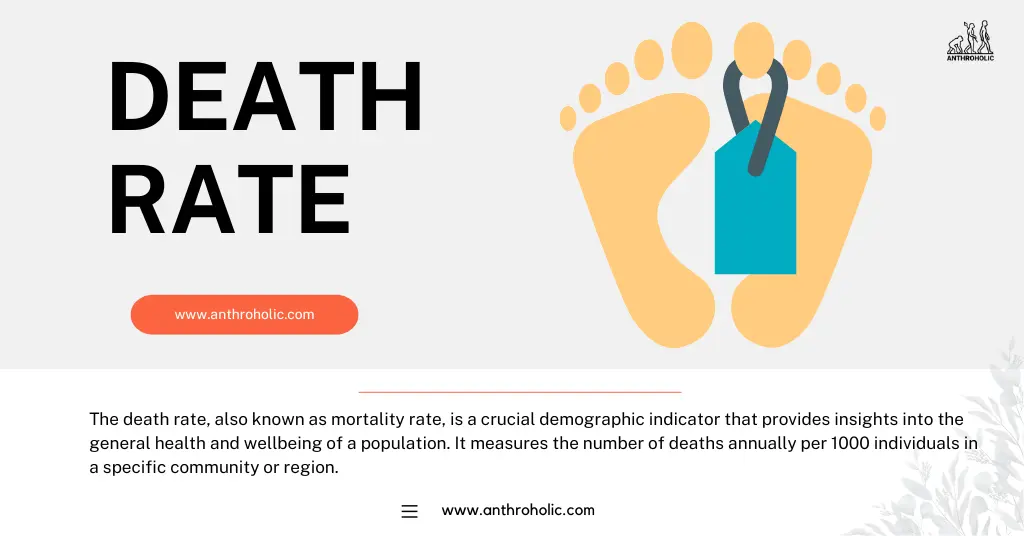AI Answer Evaluation Platform Live Now. Try Free Answer Evaluation Now
Death Rate
The death rate, also known as mortality rate, is a crucial demographic indicator that provides insights into the general health and wellbeing of a population. It measures the number of deaths annually per 1000 individuals in a specific community or region [1]. The death rate is a complex statistic influenced by several factors like age distribution, public health practices, and socio-economic conditions. This article will provide an in-depth exploration of death rates, their calculation, factors affecting them, and their impact on society.

Understanding Death Rate
Definition and Calculation
The death rate, often expressed as the number of deaths per 1,000 individuals per year, is a statistical measure that quantifies the mortality level within a population [2]. It is calculated using the following formula:
Death Rate = (Number of Deaths / Population) x 1000
An important consideration when calculating death rates is the time period involved. This measurement is typically annual, providing a snapshot of mortality within a given year.
Types of Death Rates
Death rates can be categorized into several types [3]:
- Crude Death Rate: This is the total number of deaths per 1,000 individuals in a population. It does not account for age-specific mortality factors.
- Age-Specific Death Rate: This accounts for the age of individuals, providing a more detailed picture of mortality.
- Infant Mortality Rate: This is the number of deaths of infants under one year old per 1,000 live births.
- Child Mortality Rate: This is the number of deaths of children under the age of five per 1,000 live births.
Factors Influencing Death Rates
A myriad of factors influence death rates, including:
- Age Distribution: Populations with more elderly individuals typically have higher death rates due to natural aging processes and age-related health complications [4].
- Healthcare Access: Populations with better access to healthcare services typically have lower death rates [5].
- Socioeconomic Conditions: Poverty and lack of education can lead to higher death rates, as these conditions often result in poor nutrition, unsafe living conditions, and limited access to healthcare.
- Lifestyle Factors: Behaviors such as smoking, alcohol consumption, and unhealthy diets can significantly impact death rates.
- Public Health Measures: The implementation of public health initiatives, such as vaccination campaigns and health education programs, can decrease death rates [6].
The Impact of Death Rates on Society
High death rates, particularly those associated with specific diseases or conditions, can reveal significant public health issues that need to be addressed. They can trigger the implementation of policies aimed at reducing mortality, such as improved healthcare services, health education programs, and lifestyle interventions.
Conversely, low death rates can indicate a population’s overall health and prosperity, but they can also pose challenges. For instance, lower death rates accompanied by lower birth rates can result in an aging population, potentially placing increased pressure on social and healthcare services.
Global Comparison of Death Rates
As of 2021, the countries with the highest and lowest crude death rates were as follows [7]:
| Country | Death Rate (per 1,000 people) |
|---|---|
| Bulgaria | 15.5 |
| Lesotho | 14.9 |
| Lithuania | 14.5 |
| Serbia | 13.9 |
| Latvia | 13.8 |
|---|---|
| Qatar | 1.6 |
| United Arab Emirates | 1.8 |
| Kuwait | 2.1 |
| Bahrain | 2.4 |
| Singapore | 2.4 |
Conclusion
Understanding death rates is critical for assessing public health, guiding policy-making, and predicting future societal changes. This demographic indicator, while seemingly straightforward, is a complex reflection of a population’s health, lifestyle, socio-economic conditions, and even government policies. As we strive for improved global health, monitoring and understanding death rates will continue to be of paramount importance.
References:
[1] World Health Organization. (2019). Death Rate. https://www.who.int
[2] Statistics How To. (2020). Death Rate: Definition. https://www.statisticshowto.com
[3] Centers for Disease Control and Prevention. (2021). Types of Death Rates. https://www.cdc.gov
[4] National Institute on Aging. (2021). Aging and Health. https://www.nia.nih.gov
[5] World Bank. (2020). Universal Health Coverage. https://www.worldbank.org
[6] World Health Organization. (2021). Public Health Measures. https://www.who.int
[7] World Population Review. (2021). Death Rates by Country. https://www.worldpopulationreview.com




